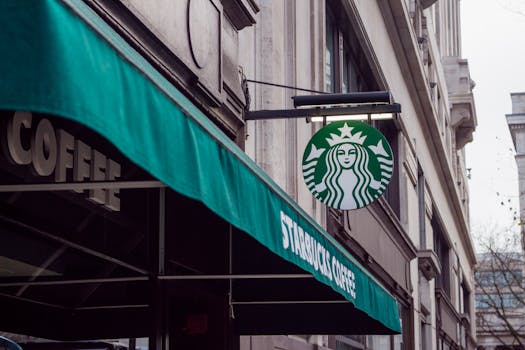The Rise of Starbucks: Howard Schultz and the Coffee Revolution

Starbucks, a name synonymous with coffee culture worldwide, owes much of its success to the vision and determination of Howard Schultz. From its humble beginnings in Seattle to becoming a global coffeehouse giant, Starbucks has revolutionized how we experience coffee. This transformation is deeply tied to Schultz's innovative strategies and relentless pursuit of quality.
In the early 1980s, Schultz joined Starbucks when it was still a small coffee bean retailer. He saw an untapped potential in creating a space where people could gather and enjoy not just coffee but a sense of community. Inspired by Italy's espresso bars, Schultz envisioned Starbucks as a "third place" between home and work, offering a unique and inviting atmosphere.
Under Schultz's leadership, Starbucks grew from a handful of stores to thousands worldwide. His focus on premium quality, customer experience, and ethical sourcing set new standards in the industry. The rise of Starbucks is more than just a business success story; it's a testament to how visionary leadership can transform an entire industry.
The Early Days
Starbucks began in 1971 in Seattle's Pike Place Market, founded by three partners: Jerry Baldwin, Zev Siegl, and Gordon Bowker. Initially, the company focused on selling high-quality coffee beans and equipment rather than brewed coffee. Howard Schultz joined the company in 1982 as Director of Retail Operations and Marketing.
Schultz's trip to Italy in 1983 was a turning point. He was captivated by the Italian coffee culture and saw an opportunity to bring that experience back to the United States. Despite initial resistance from the original founders, Schultz convinced them to test the concept of an espresso bar.
The Transformation
By 1987, Schultz had acquired Starbucks with the help of investors and began transforming it into a coffeehouse chain. His vision extended beyond just serving coffee; he aimed to create an environment where people could relax, socialize, and work. The introduction of comfortable seating, free Wi-Fi, and a welcoming atmosphere became key elements of the Starbucks experience.
Schultz's commitment to quality was unwavering. He insisted on using only the finest Arabica beans and implemented rigorous training programs for baristas to ensure consistency across all stores. This focus on quality helped distinguish Starbucks from other coffee retailers.
Expansion and Innovation
Under Schultz's leadership, Starbucks embarked on an aggressive expansion strategy. By the mid-1990s, the company had opened hundreds of stores across North America. International expansion soon followed, with Starbucks entering markets in Asia, Europe, and Latin America.
Innovation played a crucial role in Starbucks' growth. The introduction of drive-thru locations, mobile ordering, and loyalty programs enhanced convenience for customers. Seasonal offerings like the Pumpkin Spice Latte created buzz and attracted new customers.
Ethical Sourcing and Sustainability
Schultz also prioritized ethical sourcing and sustainability. In 2004, Starbucks launched its Coffee and Farmer Equity (C.A.F.E.) Practices program to ensure responsible sourcing of coffee beans. The program focuses on fair wages for farmers, environmentally friendly practices, and high-quality standards.
The company's commitment to sustainability extends beyond sourcing. Starbucks has set ambitious goals for reducing waste and conserving resources. Initiatives like eliminating plastic straws and promoting reusable cups reflect its dedication to environmental responsibility.
The Impact on Coffee Culture
The rise of Starbucks has had a profound impact on global coffee culture. It popularized specialty coffee drinks like lattes, cappuccinos, and frappuccinos, making them accessible to mainstream consumers. The concept of the "third place" has also influenced how people view cafes as social hubs rather than just places to grab a quick drink.
| Year | Milestone |
|---|---|
| 1971 | Starbucks founded in Seattle |
| 1982 | Howard Schultz joins Starbucks |
| 1987 | Schultz acquires Starbucks |
| 1992 | Starbucks goes public |
| 2004 | C.A.F.E Practices program launched |
| 2021 | 50th anniversary of Starbucks |
A Legacy of Innovation
Howard Schultz stepped down as CEO in 2017 but left behind a legacy of innovation that continues to drive Starbucks forward. The company remains committed to exploring new ways to enhance customer experience through technology and product offerings.
Schultz's influence extends beyond Starbucks. His leadership principles have inspired countless entrepreneurs and business leaders worldwide. His focus on employee welfare, social responsibility, and community engagement set new benchmarks for corporate ethics.
The Future of Starbucks
As Starbucks looks to the future, it faces both opportunities and challenges. The company continues to expand its global footprint while adapting to changing consumer preferences. The rise of digital technology presents new avenues for growth through online ordering and delivery services.
Sustainability remains a core focus for Starbucks. The company aims to become resource-positive by reducing its environmental footprint and investing in renewable energy sources. Ongoing efforts to support farmers and promote ethical sourcing will also play a crucial role in its future strategy.
The story of Starbucks is one of transformation driven by visionary leadership and unwavering commitment to quality. Howard Schultz's influence has left an indelible mark on the coffee industry, shaping how we enjoy our daily brew.